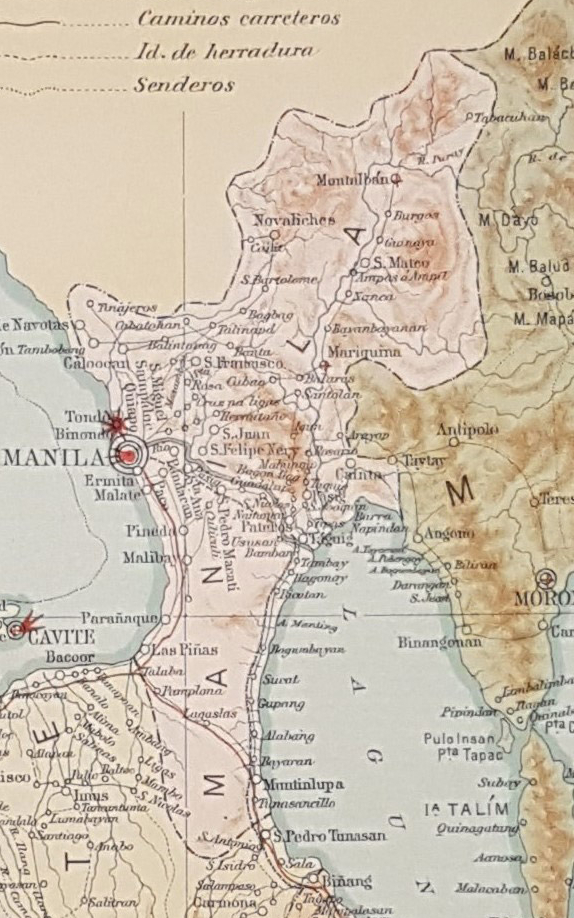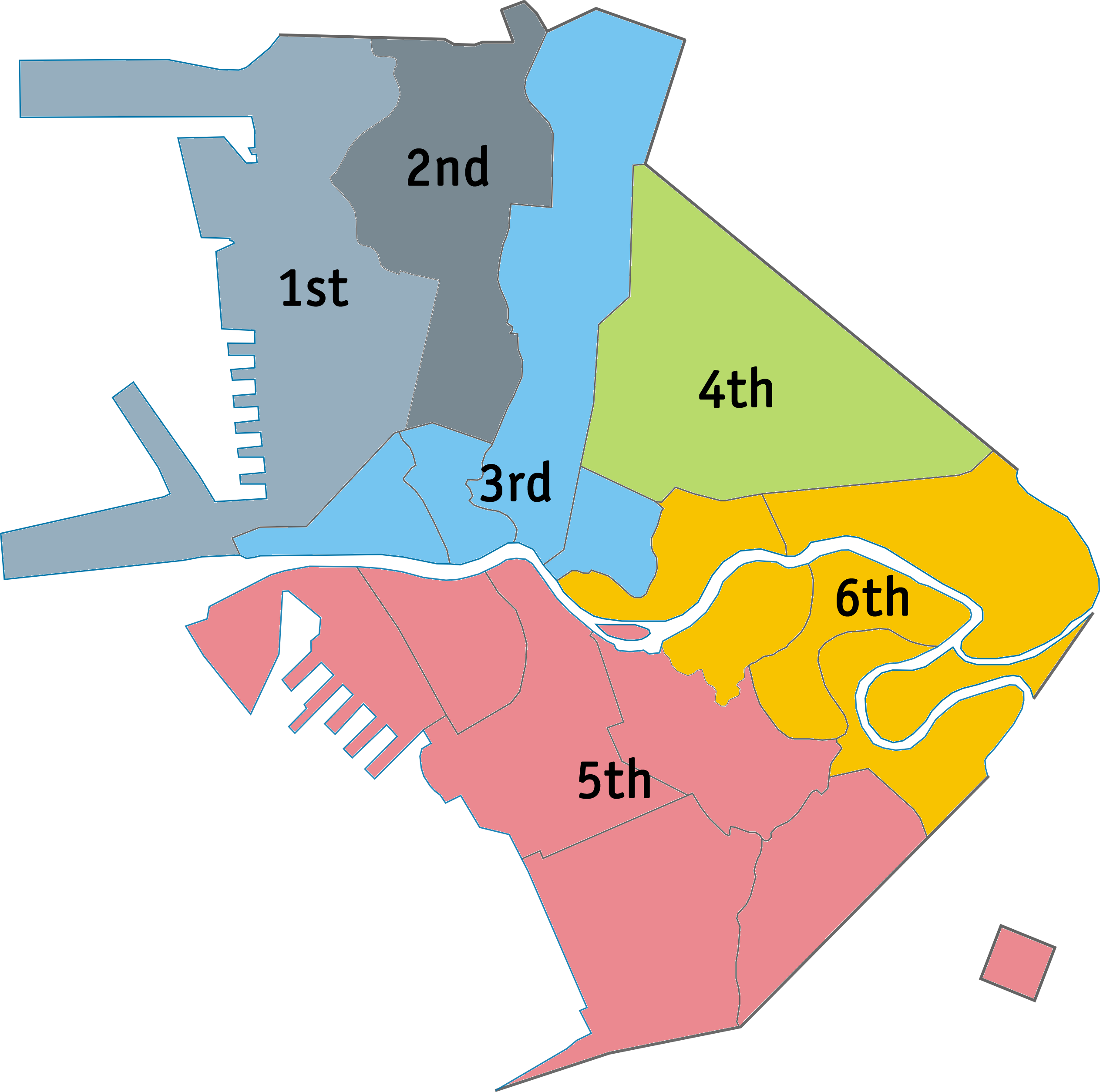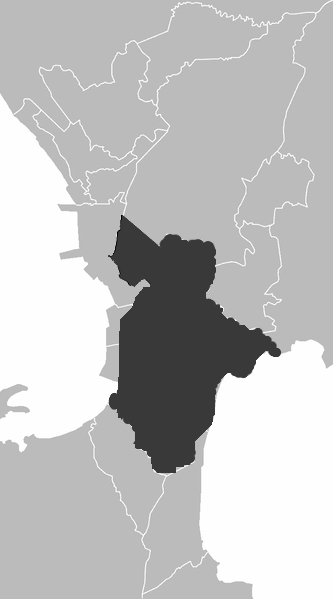|
City Of Greater Manila
The City of Greater Manila, also known simply as Greater Manila and sometimes Greater Manila Area (GMA), was a chartered city which existed during the World War II era. It was governed by the Commonwealth of the Philippines and was dissolved by Japanese occupation forces. It served as a model for the present-day Metro Manila and the administrative functions of the Governor of Metro Manila, both established three decades later during the administration of President Ferdinand Marcos. Greater Manila was formed on January 1, 1942, by virtue of Executive Order No. 400 signed by President Manuel L. Quezon as an emergency measure. It was a merger of the cities of Manila and Quezon City and the then-Rizal towns of Caloocan, Makati, Mandaluyong, Parañaque, Pasay, and San Juan. Jorge B. Vargas was appointed Mayor of Greater Manila in December 1941. He then appointed León Guinto as his successor a month later, in January 1942. Mayors of the towns and cities that comprised Greater Manil ... [...More Info...] [...Related Items...] OR: [Wikipedia] [Google] [Baidu] |
Cities Of The Philippines
A city ( fil, lungsod/siyudad) is one of the units of local government in the Philippines. All Philippine cities are chartered cities ( fil, nakakartang lungsod), whose existence as corporate and administrative entities is governed by their own specific municipal charters in addition to the Local Government Code of 1991, which specifies their administrative structure and powers. As of December 17, 2022, there are 148 cities. A city is entitled to at least one representative in the House of Representatives if its population reaches 250,000. Cities are allowed to use a common seal. As corporate entities, cities have the power to take, purchase, receive, hold, lease, convey, and dispose of real and personal property for its general interests, condemn private property for public use (eminent domain), contract and be contracted with, sue and exercise all the powers conferred to it by Congress. Only an Act of Congress can create or amend a city charter, and with this city charter Cong ... [...More Info...] [...Related Items...] OR: [Wikipedia] [Google] [Baidu] |
Rizal
Rizal, officially the Province of Rizal ( fil, Lalawigan ng Rizal), is a Provinces of the Philippines, province in the Philippines located in the Calabarzon region in Luzon. Its capital is the city of Antipolo. It is about east of Manila. The province is named after José Rizal, one of the main national heroes of the Philippines. Rizal is bordered by Metro Manila to the west, Bulacan to the north, Quezon to the east and Laguna province, Laguna to the southeast. The province also lies on the northern shores of Laguna de Bay, the largest lake in the country. Rizal is a mountainous province perched on the western slopes of the southern portion of the Sierra Madre (Philippines), Sierra Madre mountain range. Pasig served as its capital until 2008, even it became a part of the newly created Metro Manila, National Capital Region since November 7, 1975. A provincial capitol has been in Antipolo since 2009, making it the administrative center. On June 19, 2020, President Rodrigo Duterte ... [...More Info...] [...Related Items...] OR: [Wikipedia] [Google] [Baidu] |
History Of Metro Manila
Metropolitan Manila (often shortened as Metro Manila; fil, Kalakhang Maynila), officially the National Capital Region (NCR; fil, link=no, Pambansang Punong Rehiyon), is the seat of government and one of three defined metropolitan areas in the Philippines. It is composed of 16 highly urbanized cities: the city of Manila, Quezon City, Caloocan, Las Piñas, Makati, Malabon, Mandaluyong, Marikina, Muntinlupa, Navotas, Parañaque, Pasay, Pasig, San Juan, Taguig, and Valenzuela, as well as the municipality of Pateros. The region encompasses an area of and a population of as of 2020. It is the second most populous and the most densely populated region of the Philippines. It is also the 9th most populous metropolitan area in Asia and the 5th most populous urban area in the world. The region is the center of culture, economy, education and government of the Philippines. Designated as a global power city, the region exerts a significant impact on commerce, finance, media, art, ... [...More Info...] [...Related Items...] OR: [Wikipedia] [Google] [Baidu] |
Former Cities In The Philippines
A former is an object, such as a template, gauge or cutting die, which is used to form something such as a boat's hull. Typically, a former gives shape to a structure that may have complex curvature. A former may become an integral part of the finished structure, as in an aircraft fuselage, or it may be removable, being using in the construction process and then discarded or re-used. Aircraft formers Formers are used in the construction of aircraft fuselage, of which a typical fuselage has a series from the nose to the empennage, typically perpendicular to the longitudinal axis of the aircraft. The primary purpose of formers is to establish the shape of the fuselage and reduce the column length of stringers to prevent instability. Formers are typically attached to longerons, which support the skin of the aircraft. The "former-and-longeron" technique (also called stations and stringers) was adopted from boat construction, and was typical of light aircraft built until the ... [...More Info...] [...Related Items...] OR: [Wikipedia] [Google] [Baidu] |
Sergio Osmeña
Sergio Osmeña Sr. (, ; 9 September 1878 – 19 October 1961) was a Filipino lawyer and politician who served as the fourth president of the Philippines from 1944 to 1946. He was vice president under Manuel L. Quezon. Upon Quezon's sudden death in 1944, Osmeña succeeded him at age 65, becoming the oldest person to assume the Philippine presidency until Rodrigo Duterte took office in 2016 at age 71. A founder of the Nacionalista Party, Osmeña was also the first Visayan to become president. Prior to his accession in 1944, Osmeña served as governor of Cebu from 1906 to 1907, member and first speaker of the Philippine House of Representatives from 1907 to 1922, and senator from the 10th senatorial district for thirteen years, in which capacity he served as Senate president pro tempore. In 1935, he was nominated to be the running-mate of Senate President Manuel L. Quezon for the presidential election that year. The duo were overwhelmingly re-elected in 1941. He was the p ... [...More Info...] [...Related Items...] OR: [Wikipedia] [Google] [Baidu] |
Legislative Districts Of Manila
The highly urbanized city of Manila is currently represented in the House of Representatives of the Philippines by its six congressional districts. Every three years, each district elects one representative who will sit on their behalf in Congress. In addition, each district is allotted six seats in the Manila City Council, with councilors being elected every three years. History Areas now under the jurisdiction of Manila were initially represented as part of the at-large district of the province of Manila in the Malolos Congress from 1898 to 1899; the district elected four representatives. The city of Manila, chartered in 1901, first gained separate representation in 1907. It was initially divided into two representative districts from 1907 to 1949. When seats for the upper house of the Philippine Legislature were elected from territory-based districts between 1916 and 1935, the city formed part of the fourth senatorial district which elected two out of the 24-member Sen ... [...More Info...] [...Related Items...] OR: [Wikipedia] [Google] [Baidu] |
Manila's At-large Congressional District
Manila's at-large congressional district may refer to three occasions when a city-wide or provincewide at-large district was used for elections to the various Philippine national legislatures from Manila. From 1898 to 1901, four representatives from the province of Manila who were elected at-large sat in the Malolos Congress, the National Assembly of the First Philippine Republic. The city and province were separated in 1901 with both electing their representatives from two districts each. From 1943 to 1944, the city of greater Manila as a whole sent two representatives to the National Assembly of the Second Philippine Republic. Multiple district representation was restored in the city in 1945. In 1978, regional at-large assembly districts were created for the national parliament with Manila included in the 21-seat Region IV's at-large district. The city returned to its own single multi-member at-large district in 1984 with a six-seat delegation for the Regular Batasang Pambansa ... [...More Info...] [...Related Items...] OR: [Wikipedia] [Google] [Baidu] |
Second Philippine Republic
The Second Philippine Republic, officially known as the Republic of the Philippines ( tl, Repúbliká ng Pilipinas; es, República de Filipinas; ja, フィリピン共和国, ''Firipin-kyōwakoku'') and also known as the Japanese-sponsored Philippine Republic, was a Japanese puppet state established on October 14, 1943 during the Japanese occupation of the islands. Background After the Japanese invasion of the Philippines, President Manuel L. Quezon had declared the national capital Manila an "open city", and left it under the rule of Jorge B. Vargas, as mayor. The Japanese entered the city on January 2, 1942, and established it as the capital. Japan fully captured the Philippines on May 6, 1942, after the Battle of Corregidor. General Masaharu Homma decreed the dissolution of the Commonwealth of the Philippines and established the Philippine Executive Commission (), a caretaker government, with Vargas as its first chairman in January 1942. KALIBAPI — ( Tagalog for the "A ... [...More Info...] [...Related Items...] OR: [Wikipedia] [Google] [Baidu] |
National Assembly (Second Philippine Republic)
The National Assembly was the legislature of the Second Philippine Republic from September 25, 1943, to February 2, 1944. Half of the membership of the assembly consisted of provincial governors or city mayors acting in an '' ex officio'' capacity, while the other half were indirectly elected through local conventions of KALIBAPI members during the Japanese occupation of the Philippines. Legislation The National Assembly of the Second Philippine Republic passed a total of 66 laws: Act No. 1 to 66. Major legislation *Act No. 1 – ''Creation of the Ministry of Foreign Affairs'' Leadership President *President of the Second Philippine Republic: :: José P. Laurel (KALIBAPI) National Assembly *Speaker: :: Benigno S. Aquino (KALIBAPI, Tarlac) *Floor Leader: ::Francisco Zulueta (KALIBAPI, Bacolod) Members The assembly consisted of 108 members from 46 provinces and 8 chartered cities. The numbers and territorial coverages of these areas differed from the pre-war status in sev ... [...More Info...] [...Related Items...] OR: [Wikipedia] [Google] [Baidu] |
San Juan, Metro Manila
San Juan, officially the City of San Juan ( fil, Lungsod ng San Juan), is a 1st class highly urbanized city in the National Capital Region of the Philippines. According to the 2020 census, it has a population of 126,347 people. It is geographically located at Metro Manila's approximate center and is also the country's smallest city in terms of land area. The city is known historically for the site of the first battle of the Katipunan, the organization which led the 1896 Philippine Revolution against the Spanish Empire. Notable landmarks today such as Pinaglabanan Shrine and heritage homes are located in the city. Other locations include Greenhills and Santolan Town Plaza, making the city a major shopping hub with a range of upscale, boutique and bargain retail. Etymology "San Juan" is a contraction of the city's traditional name of "San Juan del Monte" (). As with numerous other places in the Philippines, the name combines a patron saint and a toponym; in this case Saint Joh ... [...More Info...] [...Related Items...] OR: [Wikipedia] [Google] [Baidu] |
Pasay
Pasay, officially the City of Pasay ( fil, Lungsod ng Pasay; ), is a 1st class Cities of the Philippines#Legal classification, highly urbanized city in the Metro Manila, National Capital Region of the Philippines. According to the 2020 census, it has a population of 440,656 people. Due to its location just south of Manila, Pasay quickly became an urban town during the History of the Philippines (1898–1946), American colonial period. History Early history In local folk history about the period before the arrival of Spanish colonizers, Pasay is said to have been part of Namayan (sometimes also called Sapa), a confederation of Barangay state, barangays which supposedly controlled territory stretching from Manila Bay to Laguna de Bay, and which, upon the arrival of the Spanish, eventually became known as Santa Ana de Sapa (modern day Santa Ana, Manila). According to these legends, the ruler of Namayan bequeathed his territories in what is now Culi-culi, Pasay, and Baclaran t ... [...More Info...] [...Related Items...] OR: [Wikipedia] [Google] [Baidu] |
Parañaque
Parañaque, officially the City of Parañaque ( fil, Lungsod ng Parañaque, ), is a first class Cities of the Philippines#Legal classification, highly urbanized city in the Metro Manila, National Capital Region of the Philippines. According to the 2020 census, it has a population of 689,992 people. It is bordered to the north by Pasay, to the northeast by Taguig, to the southeast by Muntinlupa, to the southwest by Las Piñas, and to the west by Manila Bay. Like the rest of Metro Manila, Parañaque experiences a tropical climate with only two distinct seasons, wet (July to September) and dry (October to June). The city enjoys an annual rainfall of and an average daily maximum temperature of . Parañaque is the home of the PAGCOR Entertainment City, a gaming and entertainment complex under development by the state owned Philippine Amusement and Gaming Corporation spanning an area of in Bay City, Metro Manila, Bay City, where four large integrated resorts are based namely Solaire ... [...More Info...] [...Related Items...] OR: [Wikipedia] [Google] [Baidu] |








